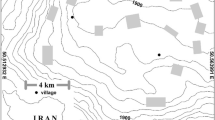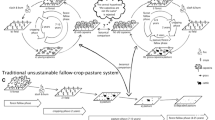Abstract
Acacia pennatula trees are the most conspicuous woody species in the pasturelands of the Nature Reserve Mesas de Moropotente, Estelí, Nicaragua. Cattle ranchers keep A. pennatula because it produces fence posts, forage (pods) and firewood. A population projection matrix model was developed to: (1) estimate the sustainable harvest (H) of fence posts at different tree population densities, (2) explore the range of recruitment (R), and survival and growth of both saplings and small poles compatible with current population density, and (3) determine how much carbon is stored in the soil-pasture-tree system. Acacia pennatula trees take 40 years to reach H size (D30 ≥ 30 cm). Estimated sustainable H from current tree population density is 1.8l7 trees ha−1 year−1, yielding 2.8 large and 11.2 regular size fence posts ha−1 year−1. This annual output easily satisfies the needs of a typical 100 ha cattle ranch in the study area. Current population density is congruent with very low R (<100 saplings ha−1 year−1), very low survival rates (<0.30%) and/or retarded D30 growth of saplings and small poles. Total carbon in tree biomass was only 37 Mg ha−1. Cattle ranchers have learned to harness the invasive nature of the species to obtain valuable tree products for farm use or sale.



Similar content being viewed by others
References
Andrade HJ, Brook R, Ibrahim M (2008) Growth, production and carbon sequestration of silvopastoral systems with native timber species in the dry lowlands of Costa Rica. Plant Soil. doi:10.1007/s11104-008-9600-x
Archer S, Pyke DA (1991) Plant-animal interactions affecting plant establishment and persistence on revegetated rangeland. J Range Manag 44:558–565
Casasola F (2000) Productividad de los sistemas silvopastoriles tradicionales en Moropotente, Estelí, Nicaragua 2000. Tesis MSc., CATIE, Turrialba, Costa Rica, p 95
Casasola F, Ibrahim M, Harvey C, Kleinn C (2001) Caracterización y productividad de sistemas silvopastoriles tradicionales en Moropotente, Estelí, Nicaragua. Agroforestería en las Américas 30:17–20
Cassel DK (1982) Tillage effects on soil bulk density and mechanical impedance. In: Predicting tillage effects on soil physical properties and processes. American Society of agronomy (ASA), special publication #44-chapter 4, Wisconsin, USA, pp 45–67
Chazaro M (1977) El Huizache Acacia pennatula (Schelecht & Cham.) Benth. Una invasora del Centro de Veracruz. Biótica 2:1–18
Correa AP (2000) Evaluación de un paisaje fragmentado para la conservación y recuperación de biodiversidad, area demostrativa Miraflor-Moropotente, Estelí, Nicaragua. Tesis MSc., CATIE, Turrialba, Costa Rica, p 137
Cruz F, García I (1988) Aprovechamiento actual y perspectivas de uso potencial de la Acacia pennatula (Schlech & Cham) Benth. En la comunidad La Unión del Municipio de Zaragoza, Distrito de Nochixtlan, Oaxaca, Chapingo XIII (60/61):76–82
Deans JD, Diagne O, Lindley DK, Dione M, Parkinson JA (1999) Nutrient and organic-matter accumulation in Acacia senegal fallows over 18 years. For Ecol Manag 124:153–167
Eshete G, Stahl G (1999) Tree rings as indicators of growth periodicity of acacias in the Rift Valley of Ethiopia. For Ecol Manag 116:107–117
Fraser AF (1985) Ethology of farm animals: a comprehensive study of the behavioral features of farm animals. Elsevier, New York
Greenberg R, Bichier P, Sterling J (1997) Acacia, cattle and migratory birds in Southeastern Mexico. Biol Conserv 80:235–247
Guevara S, Laborde J (1993) Monitoring seed dispersal at isolated standing trees in tropical pastures: consequences for local species availability. Vegetatio 107(108):319–338
Ibrahim M, Chacón M, Cuartas C, Naranjo J, Ponce G, Vega P, Casasola F, Rojas J (2007) Almacenamiento de carbono en el suelo y biomasa aérea en sistemas de usos de la tierra en paisajes ganaderos de Colombia, Costa Rica y Nicaragua. Agroforestería en las Américas 45:27–36
Janzen DH, Martin PS (1982) Neotropical anachronisms: the fruits the Gomphotheres ate. Science 215:19–27
MARENA-PANIF (1999) Plan de gestión ambiental del Paisaje Terrestre Protegido Miraflor-Moropotente. Ministerio del Ambiente y Recursos Naturales. Managua, Nicaragua, p 62
Missouri Botanical Garden (2000) Current specimen list for Acacia pennatula. W3 Specimen Data Base, St. Louis, Missouri
Molinillo MF, Farji AG (1993) Cattle as a dispersal agent of Acaena elongata (Rosaceae) in the cordillera of Merida, Venezuela. J Range Manag 46:557–561
Nelson WE, Sommers LE (1996) Total carbon, organic carbon and organic matter. In: Sparks DL (ed) Methods of soil analysis. Part 3: Chemical methods. Chapter 34. Soil Science Society of America. Madison, Wisconsin, USA, pp 961–1010
Nieto H (2000) Contribución de Acacia pennatula (Carbón) a la productividad agroforestal sostenible de la Reserva Natural Miraflor-Moropotente, Estelí, Nicaragua. Tesis MSc., CATIE, Turrialba, Costa Rica
Nieto H, Somarriba E, Gómez M (2001) Contribución de Acacia pennatula (Carbón) a la productividad agroforestal sostenible de la Reserva Natural Miraflor-Moropotente, Estelí, Nicaragua. Agroforestería en las Américas 8(30):21–23
Nuñez MB (1996) Uso de las especies forestales en 24 fincas de los Municipios de Estelí, Pueblo Nuevo y La Trinidad del Depto. de Estelí, Nicaragua. Tesis Ing. Agr., Universidad Nacional Agraria, Managua, Nicaragua, p 120
Purata SE, Greenberg R, Barrientos V, López-Portillo J (1999) Economic potential of the huizache, Acacia pennatula (Mimosoideae) in central Veracruz, Mexico. Econ Bot 53:15–29
Salas JB (1993) Árboles de Nicaragua. Instituto Nicaraguense de Recursos Naturales, Managua, Nicaragua, pp 230–231
Segura MA (1999) Valoración del servicio de fijación y almacenamiento de carbono en bosques privados en el área de conservación Cordillera Volcánica Central, Costa Rica. Tesis MSc., CATIE, Turrialba, Costa Rica, p 119
Siegler DS, Ebinger JE (1988) Acacia macracantha, A. pennatula and A. cochliancantha (Fabaceae: Mimosoidae) species complexes in Mexico. Syst Bot 13:7–15
Stewart JL, Dunsdon AJ (1994) Performance of 25 Central American dry zone hardwoods in a pantropical series of species elimination trials. For Ecol Manag 65:183–193
Stewart JL, Dunsdon AJ, Hellin JJ, Hughes CE (1992) Wood biomass estimation of Central American dry zone species. Tropical forestry papers #26. Oxford Forestry Institute, Oxford
Vanclay JK (1994) Modelling forest growth and yield: applications to mixed tropical forests. CAB International, Oxford
Woodell SRJ (1990) Regeneration in the shrub Acacia burkittii FvM. Ex Benth. In the arid zone of South Australia. Biol Conserv 51:39–48
Zúñiga C (2000) Tipologías cafetaleras y desarrollo de enfermedades en los cafetales de la Reserva Natural Miraflor–Moropotente, Estelí, Nicaragua. MSc. Tesis, CATIE, Turrialba, Costa Rica, p 68
Acknowledgments
This study was funded by PANIF-MARENA (Nicaragua), CATIE (Project Land use change and Carbon flows in Central America, CATIE-University of Helsinki; and Proyecto Cacao Centroamérica, PCC). Muhammad Ibrahim, Celia Harvey, John Beer, Lauren Fins and two anonymous reviewers made valuable suggestions for improving the scientific and written quality of the manuscript.
Author information
Authors and Affiliations
Corresponding author
Rights and permissions
About this article
Cite this article
Somarriba, E. The population dynamics and productivity of Acacia pennatula in the pasturelands of the Nature Reserve Mesas de Moropotente, Estelí, Nicaragua. Agroforest Syst 84, 1–9 (2012). https://doi.org/10.1007/s10457-011-9447-7
Received:
Accepted:
Published:
Issue Date:
DOI: https://doi.org/10.1007/s10457-011-9447-7




